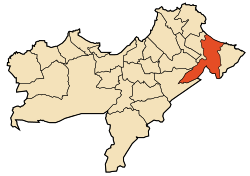


Bethioua (Arabic: بطيوة), formerly Arsenaria, Portus Magnus, Arzew (أرزيو, ʾArzyu), Vieil Arzew ("Old Arzew"), and Saint Leu, is a port town and district near ArzewinOran Province in northwestern Algeria. It has a gas port, petrochemical facilities and desalination plant.
Bethioua is located on the ruins of the ancient Roman settlement of Arsenaria or Portus Magnus.
The region itself belonged to the Battiwa (Ibeṭṭiwen), a group of Berber clans which arrived from the Rif mountains, mainly Ait Said and Temsaman tribe. They were composed of clans from Zegzawa (Izegzawen), the Ait Mait and their Maraboutic leader Sidi Amar Ben Ahmed whose mausoleum lies facing the sea.[1] Originally settled in Mazagran near the city of Mostaganem, the Ibeṭṭiwen and Battiwa the bey of Mascara gave them coastal territory a little further west[clarification needed] in 1784. Under French occupation, the Battiwa took refuge in Mazagran again.[clarification needed] Most of them were given back their land by the authorities.[who?][clarification needed][when?][2] Today only elders can still really speak the tribe language.[clarification needed][3]
When the Anglo-Americans invaded Algeria in November 1941 (Operation Torch), the American troops who captured Oran landed at Beach Z,[4] which was the strip of coastline between Arzew and Bethioua.[5]
|
| ||
|---|---|---|
| Oran District |
| |
| Aïn El Turk District |
| |
| Arzew District |
| |
| Bethioua District |
| |
| Es Sénia District |
| |
| Bir El Djir District |
| |
| Boutlélis District |
| |
| Oued Tlélat District |
| |
| Gdyel District |
| |
35°48′N 0°16′W / 35.800°N 0.267°W / 35.800; -0.267
This article about a location in Oran Province is a stub. You can help Wikipedia by expanding it. |